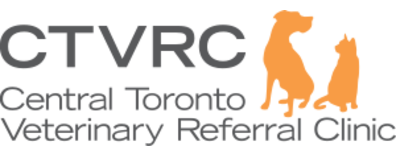Surgical Update: Canine Congenital Extrahepatic Portosystemic shunt
Surgical Update

Kristin Kry DVM MSC MS DACVS
Portosystemic shunts arise when an anomalous vessel creates an abnormal connection between the portal blood supply and the systemic circulation, bypassing the liver. Congenital extrahepatic shunts are most commonly seen in toy breeds. Yorkshire terriers have a 36 times increased risk compared to other breeds; Pug, Havanese and Miniature Schnauzers have more than 20 times increased risk. A hereditary component has been identified in Maltese dogs. There is variable presentation, ranging from incidental findings on routine pre sterilization bloodwork and subtle changes such as smaller size or a quieter demeanour. More overt changes including general or postprandial behavioural changes are noted in 30-50% of cases; these changes include lethargy, ataxia, circling, head pressing, blindness or seizures; GI signs including vomiting, pica, diarrhea and melena are seen in up to 30%; urinary tract signs including stranguria, hematuria, pollakiuria or obstruction are reported in 20-50% of patients.
All clinical signs ultimately relate to the abnormal blood flow caused by the presence of a shunt. In normal dogs, the portal vein provides 75-80% of the blood supply and 50% of the oxygen supply to the liver. The large amount of redirected blood results in reduced nutrient delivery to the liver, as well as failure to remove a large number of metabolites and toxins from the systemic circulation. There have been a large number of metabolites and toxins implicated in hepatoencephalopathy, including ammonia, amino acids, bile acids and various neurotransmitters. Excess ammonia present in the bloodstream is renally excreted and results in the formation of ammonium biurate crystaluria and calculi.
Diagnostic changes can be seen on bloodwork, urinalysis and imaging. Common findings on bloodwork include a microcytosis with or without anemia; normal to mild-moderate increases of liver enzyme values (ALT, ALP) as well as decreased liver function values (hypoalbuminemia, hypoglycemia, hypocholesterolemia, and decreased BUN). Ammonium biurate crystalluria is seen in urinalyses of 25-60% of shunt dogs. Ammonia testing is abnormal in 60-90% of shunt dogs; however this is a highly labile test and must be run immediately upon blood collection. Bile acid testing is 100% sensitive, although occasional false positives can be seen. This test is performed by collecting a fasting and a 2-hour post-prandial blood sample. It is important to stress to owners that before the fasted sample is collected, the dog should not even be exposed to food or food smells, rather than simply not allowed to eat as this can result in falsely elevated fasting sample values.
Diagnostic imaging can also be used to evaluate for shunts. On standard radiographs, microhepatica is seen in 60-100% of dogs. Ammonia biurate stones are radiolucent so will not be visible with this modality even if they are present. Abdominal ultrasound is a frequently used modality. It has 74-95% sensitivity and 67-100% specificity for diagnosing shunts; however, these values are highly operator dependent. Ammonium cystoliths can be identified with ultrasound and Doppler ultrasound can also be used to evaluate portal blood flow. Nuclear imaging, such as splenic or transcolonic scintigraphy can identify abnormal flow but is more limited in the ability to identify specific anatomy of the shunt. Portovenography can be used as an intra-operative identification for the location of the shunt vessel. Advanced imaging such as CT angiography provides a 3 dimensional image of the vasculature and has an 89% specificity and 96% sensitivity for identifying the abnormal vessel.
Once identified, treatment options include medical and surgical management. Medical management includes feeding low protein diets (18-22% protein content), lactulose, antibiotics and leviteracetem. The main goals of this therapy are to reduce the protein/ammonia load and symptomatically treat seizures. Surgical intervention includes an abdominal exploratory to identify the abnormal vessel, attenuation of the vessel as well as a cystotomy if stones are present. Complete acute ligation is not tolerated in many animals; for this reason, attenuation is more commonly performed with either an ameroid constrictor or cellophane band. Both of these devices rely primarily on foreign material reaction and fibrosis to gradually close off the vessel, although the ameroid also has a component of gradual occlusion through swelling of the inner casein ring. When placing occlusion devices, it is important to identify all braches of the shunt as some will have multiple tributaries; occlusion should happen as close as possible to the insertion of the shunt (e.g. on the cava or azygous vein) in order to include all tributaries in the occlusion.
Portal hypertension is seen in up to 15% of dogs with acute ligation; it is possible to see this complication when ameroid constrictors are used if excessive perivascular tissue is dissected prior to placement. This is often a fatal complication when it occurs. Postoperative seizures are seen in up to 20% of dogs; of these, 50% will be fatal and most of the remaining 50% will have permanent neurologic deficits. Use of leviteracetem pre-operatively has been noted to reduce the risk of these postoperative seizures. This medication is typically prescribed for at least one week prior to surgery, however it may be used for longer if preoperative neurological changes are present. When they occur, seizures are generally seen within the first 3 days postoperatively. Blindness may also be seen as a neurologic complication, however this is typically transient when it does occur. Hypoglycemia is noted in 44% of cases as soon as 4 hours postoperatively; this can be refractory to IV dextrose in 30%, but will generally resolve once the patient starts eating again. Additional perioperative complications and risks include haemorrhage, coagulopathy and thrombus formation. Persistent shunting may also be seen as a chronic complication due to incomplete attenuation, tributaries distal to the placement of the attenuating device, or formation of acquired shunts.
Six to 8 weeks postoperatively, bile acid monitoring can be used to evaluate for necessity of continued medical management in conjunction with clinical signs, however these lab values can remain persistently elevated and are not prognostic for outcome. Postoperative tapering of medications is primarily based on clinical signs. If the dog is neurologically normal, leviteracetem is often discontinued 1-2 weeks postoperatively. Antibiotics, when used preoperatively, are discontinued 2 weeks later and lactulose is tapered over the following few weeks. If the dog continues to do well, diet may be switched from a low protein liver diet, although as long as it is well tolerated, the liver diet may be continued life long, especially in dogs with persistent increases in bile acids.
Median survival time has been reported as 20-60 months of age in dogs treated with medical management alone; with only 10 months between diagnosis and euthanasia. Median survival time with surgical management is reported at 12.5 years. Long-term survival is reported in 50% of medically managed cases versus 90% of surgically managed cases. Perioperative mortality is reported in up to 30% of cases with acute ligation, however more recent rates with attenuation devices are reported around 7%, with a good to excellent long-term outcome reported in 80-95% of surgically managed dogs.
Dr. Kristin Kry is a Board Certified Small Animal Surgeon who is part of the healthcare team at the Central Toronto Veterinary Referral Clinic. She is available for referrals and consultations Tuesday to Friday. Please contact her with any surgical questions or concerns.
